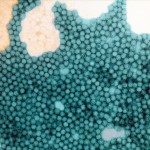Link to Pubmed [PMID] – 10954543
J. Virol. 2000 Sep;74(18):8434-43
In a previous study of poliovirus vaccine-derived strains isolated from patients with vaccine-associated paralytic poliomyelitis (VAPP) (9, 11), we reported that a high proportion (over 50%) of viruses had a recombinant genome. Most were intertypic vaccine/vaccine recombinants. However, some had restriction fragment length polymorphism (RFLP) profiles different from those of poliovirus vaccine strains. We demonstrate here that five such recombinants, of 88 VAPP strains examined, carried sequences of wild (nonvaccine) origin. To identify the parental wild donor of these sequences, we used RFLP profiles and nucleotide sequencing to look for similarity in the 3D polymerase-coding region of 61 wild, cocirculating poliovirus isolates (43 type 1, 16 type 2, and 2 type 3 isolates). In only one case was the donor identified, and it was a wild type 1 poliovirus. For the other four vaccine/wild recombinants, the wild parent could not be identified. The possibility that the wild sequences were of a non-poliovirus-enterovirus origin could not be excluded. Another vaccine/wild recombinant, isolated in Belarus from a VAPP case, indicated that the poliovirus vaccine/wild recombination is not an isolated phenomenon. We also found wild polioviruses (2 of 15) carrying vaccine-derived sequences in the 3′ moiety of their genome. All these results suggest that genetic exchanges with wild poliovirus and perhaps with nonpoliovirus enteroviruses, are also a natural means of evolution for poliovirus vaccine strains.
